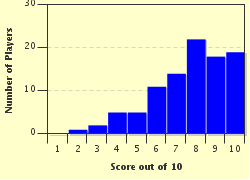Quiz Answer Key and Fun Facts
1. At its height, what was the approximate population of slaves in the southern states just before the Civil War?
2. When did the first slaves arrive in the American colonies?
3. What single crop indirectly led to a huge spike in the slave population during the period from 1787 to 1808, and further divided the North and South due to different economic systems?
4. What was the only effective slave rebellion in U.S. history?
5. In terms of citizenship, what was the status of slaves from 1787 until the Civil War?
6. What were anti-miscegenation laws?
7. What former Maryland slave escaped to the North and became a famous abolitionist, speaker, writer and living repudiation of the racist idea that slaves lacked the intelligence to be independent?
8. Many are familiar with "Uncle Tom's Cabin" as a fictional work on slavery by Harriet Beecher Stowe, but what was the reaction to it when first published in 1852?
9. What was the name of the network of secret routes, safe houses, and sympathetic people which facilitated captive slaves escaping to the North?
10. What did Abraham Lincoln issue which declared all slaves in the southern states to be free?
Source: Author
Nealzineatser
This quiz was reviewed by FunTrivia editor
bloomsby before going online.
Any errors found in FunTrivia content are routinely corrected through our feedback system.


